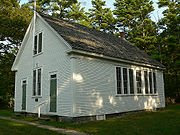When looking for a state to emulate as a model for making hard choices, you could do a lot worse than the opposite of everything California has done for its schools in the last 30 years. Beginning in 1978 and continuing to this day, California has refused to make hard decisions on behalf of its schools, and the full ramifications are starting to emerge now.
In the 1960s, California had a model school system. Half of the state’s high school graduates went to college, compared to a third in the rest of the country. As California State librarian Kevin Starr said, “There was a mood that California had to educate the work force for this wonderful future that awaited it. Public schools were being built by the hour. An entire generation of talented men and women went into Public School teaching and administration.” The wonderful future that Californians foresaw was based on the fact that major industries – including entertainment, engineering, education, technology, and agriculture – were increasingly calling California home. Lured by jobs and schools that promised bright futures, Americans from other states were moving to California by the thousands everyday. The state became the most populous in the nation in 1962, with 17 million residents.
California schools – including its admirable public universities – continued to be one of the nation’s best through the better part of the 1970s. Much of their operating funds came from property taxes, although a California Supreme Court, Serrano v. Priest, altered that to a certain extent. But in general, as real estate prices increased due to a growing population, California schools benefited. This led to better students, which led to a better work force, which led to the better future Californians foresaw.
However, 1978 changed that. In that year, California voters passed Proposition 13 as a ballot initiative. Prop 13 made two dramatic changes: the annual real estate tax on a parcel of property was limited to 1% of its assessed value, and the assessed value could only be increased by a maximum of 2% a year, unless the property changed ownership. The desired result was obtained: taxes dropped precipitously. But it also meant that as land values have increased exponentially in California over the last 30 years, schools haven’t benefited. Measured in year 2000 dollars, spending per pupil in California went from more than $600 above the national average in 1978 to more than $600 below the national average in 2000. Not surprisingly, California’s schools have plummeted. The envy of American public schools has collapsed. According to the National Assessment of Educational Progress test, only Louisiana and Mississippi students score lower in basic reading and math.
Not surprisingly, California’s future no longer looks bright. Its budget deficit has grown to over $40 billion and its bond rating has been lowered. The state’s inability to educate its work force has caught up with it as well: unemployment in California is well over 10%, which is high even for the current economic times.
Had Californians made a hard decision 30 years ago, the severity of these events could have been avoided. California’s model – higher taxes, better schools, a sought after work force – helped build California into the eighth largest economy in the world. But it required the sacrifice of higher taxes. That hard decision made the system work, and everyone in California benefited. Now, Californians are faced with much harder decisions – “Do we slash state spending by 25%? Do we increase taxes to 50%?” - if they want to save their faltering economy and state.
We would do well to learn by the California anti-model. Making the sacrifice now to pay for an excellent work force, avoids greater sacrifice in the future. And we will reap the benefits of having a thriving economy, meaning all decisions will be a little less hard. In that way, it is a sacrifice for ourselves as well as for others.
Subscribe to:
Post Comments (Atom)




No comments:
Post a Comment